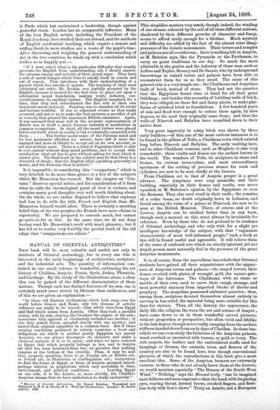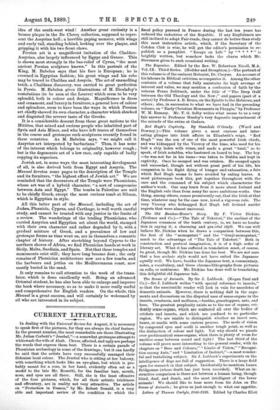MANUAL OF ORIENTAL ANTIQUITIES.* THIS book will be most valuable
and useful, not only to students of Oriental archaeology, but to every one who is interested in the early beginnings of architecture, sculpture, and the industrial arts. The quantity of information con- tained in one small volume is wonderful, embracing the art history of Chaldaaa, Assyria, Persia, Syria, Judaea, Phoenicia, and Carthage. By the study of the illustrations alone, a clear idea can be gained of the different characteristics of these nations. Though each has distinct features of its own, one is certainly much more struck by likeness than unlikeness, and of this we are given an explanation :-
" In these old Eastern civilisations which held sway over the world before Greece and Rome, only two streams of artistic influence are really to be traced,—that which rises from Egypt and that which issues from Assyria. Often they took a parallel course, side by side, sharing like brothers the empire of the arts ; sometimes they opposed or obstinately excluded one another; or else they joined forces, mingled closely with one another, and united their original capacities in a common fund. But if these varying conditions produced in certain countries a local and indigenous art which is neither purely Egyptian nor purely Assyrian, we can always decompose its elements and make a chemical analysis of it, so to speak; and when we have restored to Egypt that which properly belongs to her, and to Assyria all that has been borrowed from her, we perceive that nothing remains at the bottom of the crucible. Thus, it may be said that, properly speaking, there is no Persian art, or Hittite art, or Jewish art, or Phoenician or Carthaginian art ; everywhere we find the forms of Egypt or those of Assyria grouped, mixed, perhaps altered, in proportions which vary according to time,
environment, and political conditions Leaving Egypt on one side, it is the Asiatic, or, more strictly, the Chalcheo- Assyrian stream that we have undertaken to study exclusively."
• Manual of Oriental, Antiquities. By Ernest Babelon. Translated and Enlarged by B. T. A. Evetts, M A. With 241 Illustrations. London ; H. Grovel and Co. 1889.
This simplifies matters very mach, though, indeed, the winding of one stream, coloured by the soil of all these different nations, shadowed by their different growths of character and fancy, seems to afford study enough for a lifetime. Much mystery and difficulty are added by the fact of the almost utter disap- pearance of the Asiatic monuments. Their towers and temples and palaces are all overthrown ; there is nothing left in Assyria, as M. Babelon says, like the Pyramids or the Parthenon, to carry on great traditions to our day. So much the more admirable is the genius and the industry of those men, such as Loftus and Taylor, Heuzey and De Sarzec, who by underground borrowings in rained towns and palaces have been able to reconstruct them for us as they stood. The cause of this general ruin is a very simple one : the Chaldaaans and Assyrians built of brick, instead of stone. They had not the quarries that the Egyptians found close at hand for all their great buildings ; and besides this necessity of building walls of brick, they were obliged, on those flat and damp plains, to make plat- forms of unbaked brick as foundations. A few hundred years of rain and flood were enough to reduce these again, by slow degrees, to the mud they originally came from ; and thus the walls of Nineveh and Babylon have crumbled down to their native dust.
Very great ingenuity in using brick was shown by these early builders,—of this, one of the most curious instances is to be found in the pillars of Tello, a ChaldTan town which existed long before Nineveh and Babylon. The early vaulting here, and in other Chald.Tan remains, such as Mugheir, is also very remarkable : these vaults and domes are the earliest known in the world. The wonders of Tello, its sculpture in stone and bronze, its curious terra-cottas, and most extraordinary specimens of the cutting of precious stones for seals and cylinders, are now to be seen chiefly at the Louvre.
From Chaldzean art to that of Assyria proper is a great advance. The Assyrians were very scientific, and their building, especially in their domes and vaults, was never equalled, in M. Babelon's opinion, by the Egyptians or even the Romans. They also used wood in their roofs ; the remains of a cedar beam, no doubt originally hewn in Lebanon, and found among the ruins of a palace at Nimroud, are now to be seen at the British Museum. There, of course, and at the Louvre, Assyria can be studied better than in any book, though such a manual as this must always be invaluable for reference. Even by those who do not pretend to be students of Oriental archreology, and who only wish for a slight yet intelligent knowledge of the subject, with that " vagueness characteristic of most well-informed people," such a book as this will be found useful and agreeable. It will relieve them of the sense of confused awe which an utterly ignorant yet not stupid person must naturally feel in the presence of the great Assyrian monuments.
It is, of course, from the marvellous bas-reliefs that Oriental students have gained all their acquaintance with the appear- ance of Assyrian towns and palaces,—the staged towers, their domes overlaid with plates of wrought gold, the square gate- ways of the fortresses. The Chaldmans, with no stone or marble of their own, used to carve their rough, strange, and most powerful statuary from imported blocks of diorite and porphyry. The Assyrians possessed alabaster quarries ; thus, among them, sculptors devoted themselves almost entirely to carving in bas-relief, the material being more suitable for this than for statues. Thus, all the history, the appearance, the daily life, the religion, the wars, the art and science of Assyric, have come down to us in these wonderful carved pictures, without proportion or perspective, but often vivid and lifelike to the last degree, though never really escaping from the archaic. stiffness handed down from early days of Chaldwa. In these bas- reliefs we can even study the furniture of the Assyrian palaces, wood overlaid or encrusted with bronze, or gold, or ivory. The rich carpets, the leather and the embroidered stuffs used for hangings or dresses, the animals, trees, and flowers of the country are also to be found here, true though conventional pictures, of which the reproductions in this book give a most excellent idea. Some of the Assyrian bronzes are extremely curious: to those who do not already know them at the Louvre, we would mention especially " The Demon of the South-West Wind." " Nothing," says the Manual truly, "can be imagined more hideous and more expressive than the head, with its glaring eyes, roaring throat, horned brows, crooked fingers, and flesh- less body with lion's claws." Truly an Asiatic, not a European
idea of the south-west wind ! Another great curiosity is a bronze plaque in the De Clercq collection, supposed to repre- sent the Assyrian hell ; a horrible gaping monster, with wings and curly tail, standing behind, looking over the plaque, and gripping it with his two front claws.
Persian art is a magnificent imitation of the Chald.so- Assyrian, also largely influenced by Egypt and Greece. This is shown most strongly in the bas-relief of Cyrus, "the most ancient Persian sculpture known." In this portrait of the King, M. Babelon says that his face is European ; he is crowned in Egyptian fashion ; his great wings and his robe may be traced to Chalda.a. and Assyria. The art of enamelling brick, a Chaldman discovery, was carried to great perfection in Persia. M. Babelon gives illustrations of M. Dieulafoy's restorations (to be seen at the Louvre) which seem to be very splendid, both in colour and design. Magnificence in dress and ornament, and luxury in furniture, a general love of colour and splendour, seem to have been the ways in which Persian art chiefly showed its own character, a character which shocked and disgusted the severer taste of the Greeks.
It is a considerable descent from these great nations to the Hittites, that mixed and curious people who inhabited part of Syria and Asia Minor, and who have left traces of themselves in the coarse and grotesque rock-sculptures recently found in these countries. As M. Babelon says, " we might call it Assyrian art interpreted by barbarians." Thus, it has none of the interest which belongs to originality, however rough ; but is the degenerate art of a low race, only capable of badly copying its superiors.
Jewish art, in some ways the most interesting development of all, is also derived both from Egypt and Assyria. The Manual devotes some pages to the description of the Temple and its furniture, "the highest effort of Jewish art." We are reminded that the decorators of the Temple were Phoenicians, whose art was of a hybrid character, " a sort of compromise between Asia and Egypt." The tombs in Palestine are said to be chiefly Greek, except the most curious tomb at Siloam, which is Egyptian in style.
All this latter part of the Manual, including the art of Judaea, Phoenicia, Cyprus, and Carthage, is well worth careful study, and cannot be treated with any justice in the limits of a review. The wanderings of the 'trading Phoenicians, who carried Assyrian and Egyptian art about the world, stamped with their own character and rather degraded by it, with a gradual mixture of Greek, and a prevalence of low and grotesque forms as time went on, are in themselves a romantic chapter of history. After stretching beyond Cyprus to the northern shores of Africa, we find Phoenician hands at work in Sicily, Malta, Sardinia, and Spain. Not that these temples and monuments exist still; they have long become dust ; the only remains of Phoenician architecture now are a few tombs, and the harbours and jetties on the Mediterranean coast, now mostly buried in the sand.
It only remains to call attention to the work of the trans- lator, which is done excellently well. Being an advanced
Oriental student, he has also been able to enlarge and improve the book where necessary, so as to make it more really useful and comprehensive for English readers. On the whole, this Manual is a great success, and will certainly be welcomed by all who are interested in its subject.



































 Previous page
Previous page